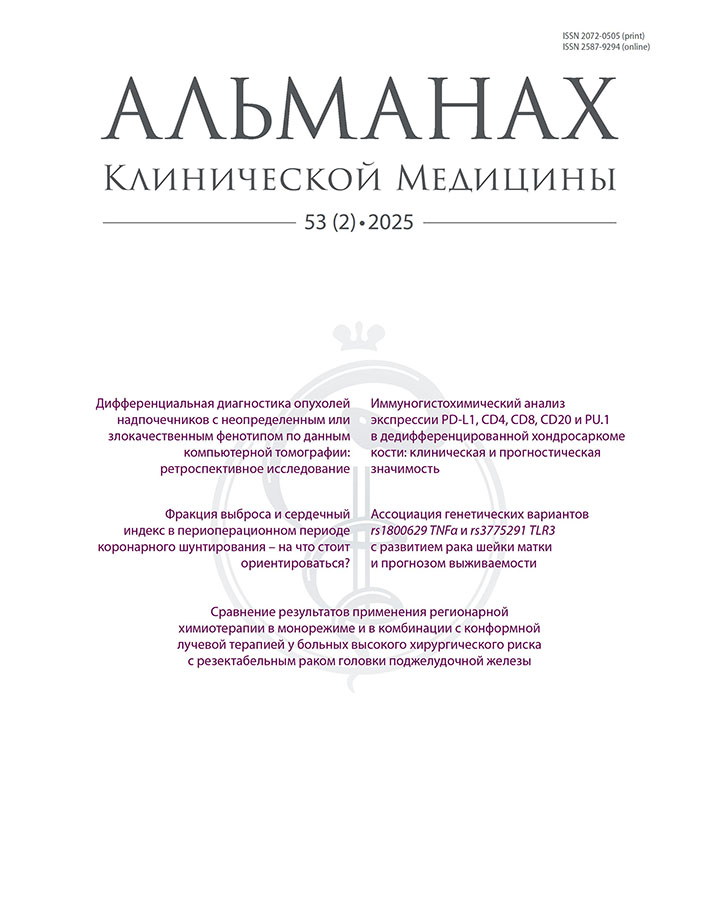Клинический случай поздней манифестации первичной надпочечниковой недостаточности в рамках аутоиммунного полигландулярного синдрома 1-го типа
- Авторы: Трошина В.В.1, Гребенникова Т.А.1, Белая Ж.Е.1
-
Учреждения:
- ФГБУ «Национальный медицинский исследовательский центр эндокринологии» Минздрава России
- Выпуск: Том 47, № 2 (2019)
- Страницы: 175-179
- Раздел: КЛИНИЧЕСКИЕ НАБЛЮДЕНИЯ
- URL: https://almclinmed.ru/jour/article/view/1006
- DOI: https://doi.org/10.18786/2072-0505-2019-47-017
- ID: 1006
Цитировать
Полный текст
Аннотация
Об авторах
В. В. Трошина
ФГБУ «Национальный медицинский исследовательский центр эндокринологии» Минздрава России
Автор, ответственный за переписку.
Email: for.troshina@gmail.com
Трошина Виктория Вадимовна – клинический ординатор,
117036, г. Москва, ул. Дмитрия Ульянова, 11
РоссияТ. А. Гребенникова
ФГБУ «Национальный медицинский исследовательский центр эндокринологии» Минздрава России
Email: fake@neicon.ru
Гребенникова Татьяна Алексеевна – канд. мед. наук, ст. науч. сотр., отделение нейроэндокринологии и остеопатий,
117036, г. Москва, ул. Дмитрия Ульянова, 11
РоссияЖ. Е. Белая
ФГБУ «Национальный медицинский исследовательский центр эндокринологии» Минздрава России
Email: fake@neicon.ru
Белая Жанна Евгеньевна – д- мед. наук, профессор, заведующая отделением нейроэндокринологии и остеопатий,
117036, г. Москва, ул. Дмитрия Ульянова, 11
РоссияСписок литературы
- Ларина АА, Трошина ЕА, Иванова ОН. Аутоиммунные полигландулярные синдромы взрослых: генетические и иммунологические критерии диагностики. В: Трошина ЕА, ред. Сборник методических рекомендаций (в помощь практическому врачу). Тверь: Триада; 2017. C. 59–74.
- Betterle C, Dal Pra C, Mantero F, Zanchetta R. Autoimmune adrenal insufficiency and autoimmune polyendocrine syndromes: autoantibodies, autoantigens, and their applicability in diagnosis and disease prediction. Endocr Rev. 2002;23(3):327–64. doi: 10.1210/edrv.23.3.0466.
- Orlova EM, Bukina AM, Kuznetsova ES, Kareva MA, Zakharova EU, Peterkova VA, Dedov II. Autoimmune polyglandular syndrome type 1 in Russian patients: clinical variants and autoimmune regulator mutations. Horm Res Paediatr. 2010;73(6):449–57. doi: 10.1159/000313585.
- Bello MO, Garla VV. Polyglandular Autoimmune Syndrome Type I. StatPearls [Internet]. Treasure Island (FL): StatPearls Publishing; 2018–2019 Jan 27.
- Корнева ЕА, Петяева АВ, Федоткина ТВ, Чурилов ЛП, Шенфельд И. Итоги и перспективы развития аутоиммунологии в мире (По материалам 11-го международного конгресса в Лиссабоне 16–20 мая 2018 года). Сообщение I: Первая академия аутоиммунитета. Медицинская иммунология. 2019;21(1): 171–88. doi: 10.15789/1563-0625-2019-1-171-188.
- Mazza C, Buzi F, Ortolani F, Vitali A, Notarangelo LD, Weber G, Bacchetta R, Soresina A, Lougaris V, Greggio NA, Taddio A, Pasic S, de Vroede M, Pac M, Kilic SS, Ozden S, Rusconi R, Martino S, Capalbo D, Salerno M, Pignata C, Radetti G, Maggiore G, Plebani A, Notarangelo LD, Badolato R. Clinical heterogeneity and diagnostic delay of autoimmune polyendocrinopathycandidiasis-ectodermal dystrophy syndrome. Clin Immunol. 2011;139(1):6–11. doi: 10.1016/j.clim.2010.12.021.
- Ahonen P, Myllärniemi S, Sipilä I, Perheentupa J. Clinical variation of autoimmune polyendocrinopathy-candidiasis-ectodermal dystrophy (APECED) in a series of 68 patients. N Engl J Med. 1990;322(26):1829–36. doi: 10.1056/NEJM199006283222601.
- Гребенникова ТА, Белая ЖЕ, Мельниченко ГА. Гипопаратиреоз: современное представление о заболевании и новые методы лечения. Эндокринная хирургия. 2017;11(2): 70–80. doi: 10.14341/serg2017270-80.
- Умярова ДШ, Гребенникова ТА, Тарбаева НВ, Белая ЖЕ. Лечение тяжелого идиопатического гипопаратиреоза на примере клинического случая. Остеопороз и остеопатии. 2018;21(2):36–40. doi: 10.14341/osteo9878.
- Saevik ÅB, Åkerman AK, Grønning K, Nermoen I, Valland SF, Finnes TE, Isaksson M, Dahlqvist P, Bergthorsdottir R, Ekwall O, Skov J, Nedrebø BG, Hulting AL, Wahlberg J, Svartberg J, Höybye C, Bleskestad IH, Jørgensen AP, Kämpe O, Øksnes M, Bensing S, Husebye ES. Clues for early detection of autoimmune Addison's disease – myths and realities. J Intern Med. 2018;283(2):190–9. doi: 10.1111/joim.12699.
- Юкина МЮ, Трошина ЕА, Платонова НМ, Бельцевич ДГ. Надпочечниковая недостаточность. В: Трошина ЕА, ред. Сборник методических рекомендаций (в помощь практическому врачу). Тверь: Триада; 2017. C. 149–92.
- Chakera AJ, Vaidya B. Addison disease in adults: diagnosis and management. Am J Med. 2010;123(5):409–13. doi: 10.1016/j.amjmed.2009.12.017.
- Barthel A, Benker G, Berens K, Diederich S, Manfras B, Gruber M, Kanczkowski W, Kline G, Kamvissi-Lorenz V, Hahner S, Beuschlein F, Brennand A, Boehm BO, Torpy DJ, Bornstein SR. An update on Addison's disease. Exp Clin Endocrinol Diabetes. 2019;127(2–03):165–75. doi: 10.1055/a-0804-2715.
- Фадеев ВВ, Мельниченко ГА. Надпочечниковая недостаточность. Русский медицинский журнал. 2001;(24):1088–94.
Дополнительные файлы








